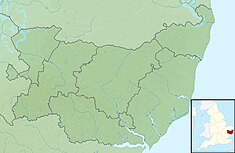
Erwarton or Arwarton is a small village and civil parish in the Babergh district of Suffolk, England. The parish includes the hamlet of Shop Corner. Located on the Shotley peninsula around 9 miles (14 km) south of Ipswich, in 2005 it had a population of 110, increasing to 126 at the 2011 Census.
Sir William Boleyn, KB of Blickling Hall in Norfolk and Hever Castle in Kent, was a wealthy and powerful landowner who served as Sheriff of Kent in 1489 and as Sheriff of Norfolk and Suffolk in 1500. He was the father of Thomas Boleyn, 1st Earl of Wiltshire, whose daughter was Queen Anne Boleyn, the second wife of King Henry VIII.
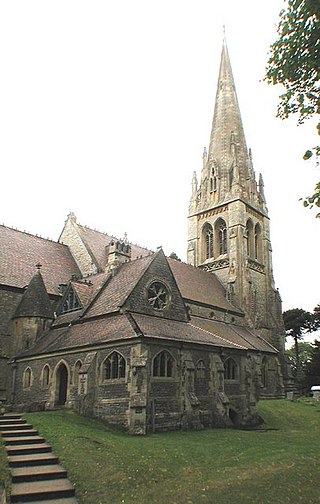
Henry Woodyer (1816–1896) was an English architect, a pupil of William Butterfield and a disciple of A. W. N. Pugin and the Ecclesiologists.
The Grade I listed buildings in Cheshire, excluding those in the city of Chester, total around 80. Almost half of these are churches that are contained in a separate list.
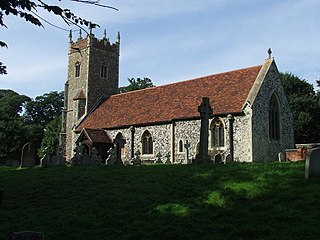
Wherstead is a village and a civil parish located in the county of Suffolk, England. Wherstead village lies 3 miles (4.8 km) south of Ipswich on the Shotley peninsula. It is in the Belstead Brook electoral division of Suffolk County Council.

Woolverstone is a small village and civil parish in Suffolk, England located on the Shotley peninsula. It is situated about 6.4 km (4.0 mi) south of Ipswich, near the southern shore of the River Orwell. In 2005 it had a population of 240, increasing to 265 at the 2011 census.
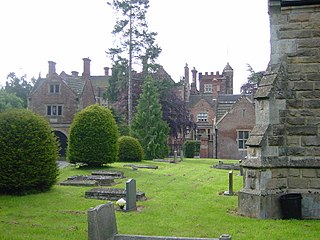
Shenton Hall is a country house, opposite the church of St John the Evangelist, within the village of Shenton, in Leicestershire, England. It is recorded in the National Heritage List for England as a designated Grade II* listed building.

Henry Parker, 10th Baron Morley, was an English peer and translator, Lord of Morley, Hingham, Hockering, &c., in Norfolk.

Heveningham Hall is a Grade I listed building in Heveningham, Suffolk, England. The first house on the site was built for the politician and regicide William Heveningham in 1658. The present house, dating from 1778 to 1780, was designed by Sir Robert Taylor for Sir Gerald Vanneck, 2nd Baronet with interiors by James Wyatt. The hall remained in the Vanneck family until 1981.

Little Henny is a hamlet and civil parish in the Braintree district in the county of Essex, England. It shares a parish council with Great Henny and Twinstead called "Hennys', Middleton & Twinstead". It is near the town of Sudbury in Suffolk. In 2001 the parish had a population of 48.
The Shotley Peninsula is a rural area east of the A137 Ipswich-Colchester road located between the rivers Stour and Orwell in Suffolk, England. The peninsula is named after the settlements of Shotley and Shotley Gate which are situated near its south-eastern tip. Other villages on the peninsula include Chelmondiston, Erwarton (Arwarton), Freston, Harkstead, Holbrook, Stutton, Tattingstone, Wherstead and Woolverstone.

Sir Henry Parker, of Morley Hall, Hingham, Norfolk and Furneux Pelham, Hertfordshire, was an English politician.

Westwood House is a stately home, near Droitwich, Worcestershire, England. It has been subdivided into twelve self-contained apartments. The house has origins as an Elizabethan banqueting hall with Caroline additions and is a Grade I listed building. It was for several centuries the seat of the Pakington family. Situated west of Droitwich, it lies in the centre of its former estate, Westwood Park, which is Grade II listed in the National Register of Historic Parks and Gardens.
Borwick is a civil parish in Lancaster, Lancashire, England. It contains 27 listed buildings that are recorded in the National Heritage List for England. Of these, three are listed at Grade I, the top grade, and the others are at Grade II, the lowest of the three grades of listing. The parish contains the village of Borwick, and is otherwise rural. The most important building in the parish is Borwick Hall; this and a number of associated buildings and structures are listed. The Lancaster Canal passes through the parish, and associated with it are five listed bridges and an aqueduct. The other listed buildings include houses, farm buildings, bridges over the River Keer, a church, a milestone, and a telephone kiosk.
Mellor is a civil parish in Ribble Valley, Lancashire, England. It contains ten listed buildings that are recorded in the National Heritage List for England. Of these, one is at Grade II*, the middle grade, and the others are at Grade II, the lowest grade. The parish contains the village of Mellor, and is otherwise rural. The only listed building in the village is the church. The other listed buildings are houses and associated structures, farmhouses, and a bridge.
Read is a civil parish in Ribble Valley, Lancashire, England. It contains seven listed buildings that are recorded in the National Heritage List for England. Of these, one is at Grade II*, the middle grade, and the others are at Grade II, the lowest grade. The most important building in the parish is the country house Read Hall; this and a number of structures in the grounds are listed. The other listed buildings are a church, a farmhouse, and a railway viaduct.
Bromfield is a civil parish in Shropshire, England. It contains 44 listed buildings that are recorded in the National Heritage List for England. Of these, one is listed at Grade I, the highest of the three grades, two are at Grade II*, the middle grade, and the others are at Grade II, the lowest grade. The parish contains the village of Bromfield and the surrounding countryside. Two buildings have retained material from the 12th century, the gatehouse of Bromfield Priory, and St Mary the Virgin's Church. In the parish is a country house, Oakly Park; this and associated structures are listed. Most of the other listed buildings are houses, cottages, farmhouses and farm buildings. Others include a public house, a former corn mill, a former sawmill, a bridge, a weir, and a war memorial.
Craven Arms is a civil parish in Shropshire, England. It contains 23 listed buildings that are recorded in the National Heritage List for England. Of these, two are listed at Grade I, the highest of the three grades, and the others are at Grade II, the lowest grade. The parish contains the small town of Craven Arms, the hamlets of Halford and Stokesay, and the surrounding countryside.
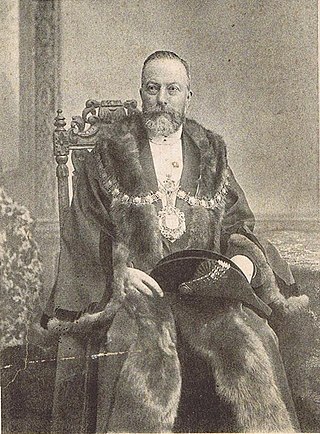
Frederic Chancellor, was an English architect and surveyor who spent much of his career working in Chelmsford, Essex, and its surrounding areas. His works included private houses, municipal buildings, churches, parsonages, banks and schools. It was during his later career that he concentrated on ecclesiastical buildings for which he became best known. A prolific architect, around 730 buildings have been attributed to him, 570 of which are in Essex.

Hemingstone Hall is a Jacobean manor house in Hemingstone close to Ipswich in Suffolk, England. It was built in the early 17th Century, around 1625, for William Style. The house is of two storeys with attics, and is built to an H-plan in red brick. James Bettley, in his 2015 revised volume, Suffolk: East, of the Pevsner Buildings of England series, records the two-storey porch with Tuscan pilasters and obelisks.

